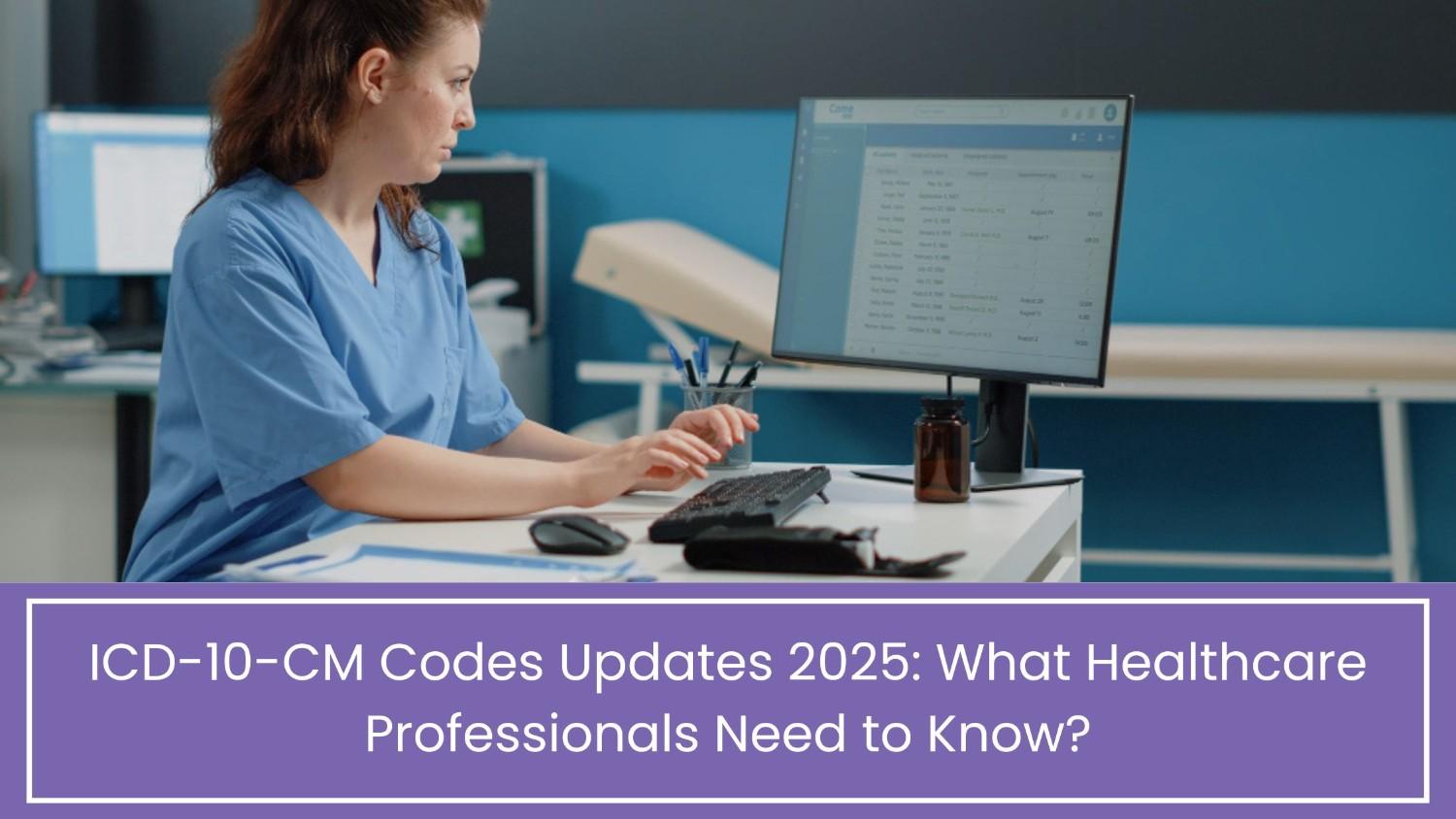ICD-10-CM Codes Updates 2025: What Healthcare Professionals Need to Know?
The ICD-10-CM codes updates 2025 introduce key coding changes that healthcare professionals must understand for accurate documentation and billing. These updates include new, revised, and deleted codes aimed at improving diagnostic precision and patient care. To maintain compliance and reduce claim denials, providers should review updated guidelines covering conditions like chronic diseases, mental health disorders, and infectious diseases. Implementing these changes requires updating electronic health records (EHR) systems, training staff, and working with coding specialists. Staying informed about ICD-10-CM 2025 updates is essential for improving coding accuracy, minimizing audit risks, and ensuring smooth revenue cycle management for healthcare organizations.
In the first part of our discussion on the 2025 updates to ICD-10-CM, we explored the updated ICD-10-CM codes up to Chapter 10. Continuing from where we left off in Part 1, let’s now focus on the remaining updates and the codes that have been removed in Part 2 of this blog.
Table of Contents
Chapter 11: Updates on Codes for Digestive System Diseases
The latest revision introduces 17 additional codes that encompass diverse clinical scenarios such as acute appendicitis complicated with extensive peritonitis, excessive bacterial or fungal growth in the small intestine, and cases of small bowel syndrome. enabling more accurate documentation and tracking of these conditions in clinical practice.
- K35.200 Acute appendicitis with generalized peritonitis, without perforation or abscess
- K35.201 Acute appendicitis with generalized peritonitis, with perforation, without abscess
- K35.209 Acute appendicitis with generalized peritonitis, without abscess, unspecified as to perforation
- K35.210 Acute appendicitis with generalized peritonitis, without perforation, with abscess
- K35.211 Acute appendicitis with generalized peritonitis, with perforation and abscess
- K35.219 Acute appendicitis with generalized peritonitis, with abscess, unspecified as to perforation
- K63.8211 Small intestinal bacterial overgrowth, hydrogen-subtype
- K63.8212 Small intestinal bacterial overgrowth, hydrogen sulfide-subtype
- K63.8219 Small intestinal bacterial overgrowth, unspecified
- K63.822 Small intestinal fungal overgrowth
- K63.829 Intestinal methanogen overgrowth, unspecified
- K68.2 Retroperitoneal fibrosis
- K68.3 Retroperitoneal hematoma
- K90.821 Short bowel syndrome with colon in continuity
- K90.822 Short bowel syndrome without colon in continuity
- K90.829 Short bowel syndrome, unspecified
- K90.83 Intestinal failure
Chapter 13: Updates to Codes for Musculoskeletal System Diseases
The recent developments in coding procedures encompass the addition of 36 new codes, specifically designed to document cases of osteoporosis-related pathological fractures occurring in the pelvis. These codes are further classified with the help of a 7th character extension, allowing for precise identification of initial encounter, repeated encounter, delay in healing, nonunion, malunion, as well as encounter for sequelae.
- M80.0B1 Age-related osteoporosis with current pathological fracture, right pelvis
- M80.0B2 Age-related osteoporosis with current pathological fracture, left pelvis
- M80.0B9 Age-related osteoporosis with current pathological fracture, unspecified pelvis
- M80.8B1 Other osteoporosis with current pathological fracture, right pelvis
- M80.8B2 Other osteoporosis with current pathological fracture, left pelvis
- M80.8B9 Other osteoporosis with current pathological fracture, unspecified pelvis
Chapter 14: Updates Regarding Codes for Genitourinary System Diseases
This chapter introduces 15 newly established diagnostic codes, covering conditions such as recurrent and enduring IgAN – Immunoglobulin A Nephropathy, the primary type of Glomerulonephropathy, a condition affecting the glomeruli in the kidneys.
- N02.B1 Recurrent and persistent immunoglobulin A nephropathy with glomerular lesion
- N02.B2 Recurrent and persistent immunoglobulin A nephropathy with focal and segmental glomerular lesion
- N02.B3 Recurrent and persistent immunoglobulin A nephropathy with diffuse membranoproliferative glomerulonephritis
- N02.B4 Recurrent and persistent immunoglobulin A nephropathy with diffuse membranous glomerulonephritis
- N02.B5 Recurrent and persistent immunoglobulin A nephropathy with diffuse mesangial proliferative glomerulonephritis
- N02.B6 Recurrent and persistent immunoglobulin A nephropathy with diffuse mesangiocapillary glomerulonephritis
- N02.B9 Other recurrent and persistent immunoglobulin A nephropathy
- N04.20 Nephrotic syndrome with diffuse membranous glomerulonephritis, unspecified
- N04.21 Primary membranous nephropathy with nephrotic syndrome
- N04.22 Secondary membranous nephropathy with nephrotic syndrome
- N04.29 Other nephrotic syndrome with diffuse membranous glomerulonephritis
- N06.20 Isolated proteinuria with diffuse membranous glomerulonephritis, unspecified
- N06.21 Primary membranous nephropathy with isolated proteinuria
- N06.22 Secondary membranous nephropathy with isolated proteinuria
- N06.29 Other isolated proteinuria with diffuse membranous glomerulonephritis
Chapter 15: Updates to Codes for Pregnancy, Labor, and the Postpartum Period
Within the most recent chapter revision, six additional medical codes have been introduced to encompass various medical conditions, including ICP- Intrahepatic Cholestasis of Pregnancy. ICP is a unique pregnancy-related disorder distinguished by the disruption of bile acid flow within the liver, leading to the accumulation of bile acids in the maternal bloodstream as well as the amniotic fluid surrounding the developing fetus.
- O26.641 Intrahepatic cholestasis of pregnancy, first trimester
- O26.642 Intrahepatic cholestasis of pregnancy, second trimester
- O26.643 Intrahepatic cholestasis of pregnancy, third trimester
- O26.649 Intrahepatic cholestasis of pregnancy, unspecified trimester
- O90.41 Hepatorenal syndrome following labor and delivery
- O90.49 Other postpartum acute kidney failure
Chapter 17: Updates on Codes for Congenital Malformations
Within the domain of congenital malformations, this chapter presents 22 new codes, providing distinct delineations for specific forms of craniosynostosis.
- Q44.70 Other congenital malformation of liver, unspecified
- Q44.71 Alagille syndrome
- Q44.79 Other congenital malformations of liver
- Q75.001 Craniosynostosis unspecified, unilateral
- Q75.002 Craniosynostosis unspecified, bilateral
- Q75.009 Craniosynostosis unspecified
- Q75.01 Sagittal craniosynostosis
- Q75.021 Coronal craniosynostosis unilateral
- Q75.022 Coronal craniosynostosis bilateral
- Q75.029 Coronal craniosynostosis unspecified
- Q75.03 Metopic craniosynostosis
- Q75.041 Lambdoid craniosynostosis, unilateral
- Q75.042 Lambdoid craniosynostosis, bilateral
- Q75.049 Lambdoid craniosynostosis, unspecified
- Q75.051 Cloverleaf skull
- Q75.052 Pansynostosis
- Q75.058 Other multi-suture craniosynostosis
- Q75.08 Other single-suture craniosynostosis
- Q87.83 Bardet-Biedl syndrome
- Q87.84 Laurence-Moon syndrome
- Q87.85 MED13L syndrome
- Q93.52 Phelan-McDermid syndrome
Chapter 18: Updates for Codes Addressing Clinical Indications, Signs, as well as Abnormal Clinical and Laboratory Discoveries
The latest updates include the incorporation of 18 new codes, addressing a diverse spectrum of medical conditions, which include the sensation of a foreign body presence as well as breast density.
- R09.A0 Foreign body sensation, unspecified
- R09.A1 Foreign body sensation, nose
- R09.A2 Foreign body sensation, throat
- R09.A9 Foreign body sensation, other site
- R40.2A Nontraumatic coma due to underlying condition
- R92.30 Dense breasts, unspecified
- R92.311 Mammographic fatty tissue density, right breast
- R92.312 Mammographic fatty tissue density, left breast
- R92.313 Mammographic fatty tissue density, bilateral breasts
- R92.321 Mammographic fibroglandular density, right breast
- R92.322 Mammographic fibroglandular density, left breast
- R92.323 Mammographic fibroglandular density, bilateral breasts
- R92.331 Mammographic heterogeneous density, right breast
- R92.332 Mammographic heterogeneous density, left breast
- R92.333 Mammographic heterogeneous density, bilateral breasts
- R92.341 Mammographic extreme density, right breast
- R92.342 Mammographic extreme density, left breast
- R92.343 Mammographic extreme density, bilateral breasts
Chapter 19: Updates Regarding Codes for Injuries and Poisoning
The most recent revision introduces 12 new diagnostic codes specifically designed to address the diverse toxic effects associated with gadolinium exposure. Within these code sets, a 7th character extension further classifies cases into initial encounters, frequent/ recurrent encounters, and encounters for long-term sequelae management.
- T56.821 Toxic effect of gadolinium, accidental (unintentional)
- T56.822 Toxic effect of gadolinium, intentional self-harm
- T56.823 Toxic effect of gadolinium, assault
- T56.824 Toxic effect of gadolinium, undetermined
Chapter 20: Updates to Codes for Morbidity-Related External Factors
The section incorporates an additional 123 new diagnostic codes specifically designed to address incidents involving foreign objects entering the body through natural orifices. These objects may include items such as buttons, batteries, plastic fragments, jewellery, and more. Furthermore, these code sets are improved with a 7th character extension, enabling differentiation between the initial encounter, more frequent encounters, as well as sequelae encounters. This enhancement ensures a comprehensive range of coding options for accurately documenting such clinical scenarios.
- W44.A0 Battery unspecified, entering into or through a natural orifice
- W44.A1 Button battery entering into or through a natural orifice
- W44.A9 Other batteries entering into or through a natural orifice
- W44.B0 Plastic object unspecified, entering into or through a natural orifice
- W44.B1 Plastic bead entering into or through a natural orifice
- W44.B2 Plastic coin entering into or through a natural orifice
- W44.B3 Plastic toy and toy part entering into or through a natural orifice
- W44.B4 Plastic jewelry entering into or through a natural orifice
- W44.B5 Plastic bottle entering into or through a natural orifice
- W44.B9 Other plastic object entering into or through a natural orifice
- W44.C0 Glass unspecified, entering into or through a natural orifice
- W44.C1 Sharp glass entering into or through a natural orifice
- W44.C2 Intact glass entering into or through a natural orifice
- W44.D0 Magnetic metal object unspecified, entering into or through a natural orifice
- W44.D1 Magnetic metal bead entering into or through a natural orifice
- W44.D2 Magnetic metal coin entering into or through a natural orifice
- W44.D3 Magnetic metal toy entering into or through a natural orifice
- W44.D4 Magnetic metal jewelry entering into or through a natural orifice
- W44.D9 Other magnetic metal objects entering into or through a natural orifice
- W44.E0 Non-magnetic metal object unspecified, entering into or through a natural orifice
- W44.E1 Non-magnetic metal bead entering into or through a natural orifice
- W44.E2 Non-magnetic metal coin entering into or through a natural orifice
- W44.E3 Non-magnetic metal toy entering into or through a natural orifice
- W44.E4 Non-magnetic metal jewelry entering into or through a natural orifice
- W44.E9 Other non-magnetic metal objects entering into or through a natural orifice
- W44.F0 Objects of natural or organic material unspecified, entering into or through a natural orifice
- W44.F1 Bezoar entering into or through a natural orifice
- W44.F2 Rubber band entering into or through a natural orifice
- W44.F3 Food entering into or through a natural orifice
- W44.F4 Insect entering into or through a natural orifice
- W44.F9 Other object of natural or organic material, entering into or through a natural orifice
- W44.G0 Other non-organic objects unspecified, entering into or through a natural orifice
- W44.G1 Audio device entering into or through a natural orifice
- W44.G2 Combination metal and plastic toy and toy part entering into or through natural orifice
- W44.G3 Combination metal and plastic jewelry entering into or through a natural orifice
- W44.G9 Other non-organic objects entering into or through a natural orifice
- W44.H0 Other sharp object unspecified, entering into or through a natural orifice
- W44.H1 Needle entering into or through a natural orifice
- W44.H2 Knife, sword or dagger entering into or through a natural orifice
- W44.8 Other foreign body entering into or through a natural orifice
- W44.9 Unspecified foreign body entering into or through a natural orifice
Chapter 21: Updates to Codes Related to Factors Affecting State of Health and Engagement with Healthcare Services
This section introduces a set of 30 new medical codes specifically developed to cover a wide spectrum of health-related conditions. These newly introduced codes encompass carrier status, historical health, and codes pertinent to SDoH- Social Determinants of Health. For instance, a notable inclusion is the establishment of the subcategory ‘Caregiver’s noncompliance with patient’s medical treatment & regimen,’ exemplifying the chapter’s emphasis on elements that can significantly impact an individual’s health status as well as interactions with healthcare services.
- Z02.84 Encounter for child welfare exam
- Z05.81 Observation and evaluation of newborn for suspected condition related to home physiologic monitoring device ruled out
- Z05.89 Observation and evaluation of newborn for other specified suspected condition ruled out
- Z16.13 Resistance to carbapenem
- Z22.340 Carrier of carbapenem-resistant Acinetobacter baumannii
- Z22.341 Carrier of carbapenem-sensitive Acinetobacter baumannii
- Z22.349 Carrier of Acinetobacter baumannii, unspecified
- Z22.350 Carrier of carbapenem-resistant Enterobacterales
- Z22.358 Carrier of other Enterobacterales
- Z22.359 Carrier of Enterobacterales, unspecified
- Z29.81 Encounter for HIV pre-exposure prophylaxis
- Z29.89 Encounter for other specified prophylactic measures
- Z62.23 Child in custody of non-parental relative
- Z62.24 Child in custody of non-relative guardian
- Z62.831 Non-parental relative-child conflict
- Z62.832 Non-relative guardian-child conflict
- Z62.833 Group home staff-child conflict
- Z62.892 Runaway [from current living environment]
- Z83.710 Family history of adenomatous and serrated polyps
- Z83.711 Family history of hyperplastic colon polyps
- Z83.718 Other family history of colon polyps
- Z83.719 Family history of colon polyps, unspecified
- Z91.A41 Caregiver’s other noncompliance with patient’s medication regimen due to financial hardship
- Z91.A48 Caregiver’s other noncompliance with patient’s medication regimen for other reason
- Z91.A51 Caregiver’s noncompliance with patient’s renal dialysis due to financial hardship
- Z91.A58 Caregiver’s noncompliance with patient’s renal dialysis for other reason
- Z91.A91 Caregiver’s noncompliance with patient’s other medical treatment and regimen due to financial hardship
- Z91.A98 Caregiver’s noncompliance with patient’s other medical treatment and regimen for other reason
- Z91.85 Personal history of military service
- Z91.89 Other specified personal risk factors, not elsewhere classified
In the initial section of the blog (PART-1), we mentioned that 25 codes will no longer be in use in ICD-10, effective from 2025. Now, let’s look into the list of codes that are being removed:
- 9 Benign neoplasm of ill-defined sites within the digestive system
- 1 Neoplasm of uncertain behavior of connective and other soft tissue
- 8 Other hypoparathyroidism
- 8 Other disorders of purine and pyrimidine metabolism
- 81 Metabolic syndrome
- G20 Parkinson’s disease
- 8 Other specified demyelinating diseases of central nervous system
- H36 Retinal disorders in diseases classified elsewhere
- 8 Other forms of angina pectoris
- 8 Other forms of acute ischemic heart disease
- 1 Supraventricular tachycardia
- 6 Pneumonia due to other Gram-negative bacteria
- 20 Acute appendicitis with generalized peritonitis, without abscess
- 21 Acute appendicitis with generalized peritonitis, with abscess
- 2 Nephrotic syndrome with diffuse membranous glomerulonephritis
- 2 Isolated proteinuria with diffuse membranous glomerulonephritis
- 4 Postpartum acute kidney failure
- 7 Other congenital malformations of liver
- 0 Craniosynostosis
- 8 Observation and evaluation of newborn for other specified suspected condition ruled out
- 8 Encounter for other specified prophylactic measures
- 71 Family history of colonic polyps
- A4 Caregiver’s other noncompliance with patient’s medication regimen
- A5 Caregiver’s noncompliance with patient’s renal dialysis
- A9 Caregiver’s noncompliance with patient’s other medical treatment and regimen
Final Thoughts
The ICD-10-CM 2025 updates bring significant changes and additions that healthcare professionals must be well-informed about. These updates reflect the evolving landscape of medical knowledge and clinical practices. With 395 new codes, 25 removals, and 22 modifications, these revisions enhance the accuracy and specificity of diagnostic coding across various medical specialties. From addressing infectious diseases and rare conditions like desmoid tumors to providing codes for sickle-cell anemia with dactylitis and complex neurodegenerative disorders, these updates empower healthcare providers to document and treat a wide range of medical conditions more precisely. Additionally, the inclusion of codes related to social determinants of health underlines the importance of addressing non-medical factors that impact patients’ well-being.
These changes not only streamline billing and reimbursement processes but also contribute to improved patient care, research, and public health reporting. As healthcare professionals, staying up-to-date with these updates is vital to navigate the ever-evolving world of healthcare coding and diagnosis effectively. The ICD-10-CM 2025 updates pave the way for more accurate and comprehensive healthcare documentation, ultimately benefiting both patients and the healthcare industry as a whole.
Practolytics: Your Source for Up-to-Date Coding Excellence!
Practolytics is your trusted partner for up-to-date coding services. Our ICD-10-CM 2025 coding expertise ensures efficient billing and accurate documentation, ultimately leading to better patient outcomes.
In the healthcare landscape, accurate coding is crucial. Practolytics stays ahead of the curve, providing you with the latest ICD-10-CM 2025 codes. Our dedicated team ensures that your coding is precise, reducing errors and improving revenue.
Don’t fall behind. Choose Practolytics for comprehensive, up-to-date coding services. To know more, contact us at +(803) 932-9624 or mail us at [email protected]. Elevate your coding game with Practolytics!
* For more information, you can refer to the links below:
Centers for Medicare & Medicaid Services (CMS) (or) Centers for Disease Control and Prevention (CDC)*
ALSO READ – ICD-10-CM 2024 Updates: Part – 1
Talk to Medical Billing Expert Today — Get a Free Demo Now!






